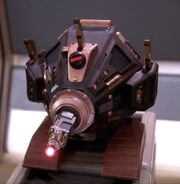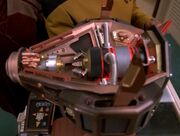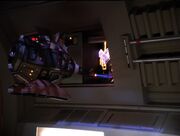Renegade54 (talk | contribs) m (Reverted edits by 72.54.221.146 (talk | block) to last version by 162.157.110.226) |
|||
| (16 intermediate revisions by 10 users not shown) | |||
| Line 1: | Line 1: | ||
| − | {{featuredremoval}} |
||
| − | |||
[[File:Exocomp with tool.jpg|thumb|An exocomp with a mode stabilizer]] |
[[File:Exocomp with tool.jpg|thumb|An exocomp with a mode stabilizer]] |
||
| − | '''Exocomps''' were [[artificial lifeform]]s designed by [[ |
+ | '''Exocomps''' were [[artificial lifeform]]s designed by the [[Tyran]] [[Doctor]] [[Farallon]] that had gained [[sentient|sentience]]. |
== Origins == |
== Origins == |
||
| − | Farallon began working on an exocomp [[prototype]] several |
+ | Farallon began working on an exocomp [[prototype]] several [[year]]s prior to [[2369]] when she had three working units in operation at the [[Particle Fountain Project]] for maintenance purposes. The exocomp was not intended to be sentient, but due to the adaptive nature of its design it [[evolution|evolved]], gaining sentience. |
The basis of the exocomp was an industrial servo mechanism which had been in common use on [[Tyrus VIIa]] for many years. This basic design was extended by Dr. Farallon who named them 'exocomps'. The main design goal was to make the exocomp a problem-solver. |
The basis of the exocomp was an industrial servo mechanism which had been in common use on [[Tyrus VIIa]] for many years. This basic design was extended by Dr. Farallon who named them 'exocomps'. The main design goal was to make the exocomp a problem-solver. |
||
| Line 15: | Line 13: | ||
Problems to be solved could be entered through a command-pad, after which the exocomp decided what kind of tool it had to use and then replicated that tool. |
Problems to be solved could be entered through a command-pad, after which the exocomp decided what kind of tool it had to use and then replicated that tool. |
||
| − | == Recognition of |
+ | == Recognition of sentience == |
[[Lieutenant Commander]] [[Data]] was testing an exocomp on the particle fountain and had completed nineteen separate tests when the device was sent into an [[access tunnel]] to seal a [[plasma conduit]]. The exocomp returned without finishing its task. When Dr. Farallon tried to send it back into the access tunnel by overriding the exocomp's commands, her control pad overloaded. A few seconds later the plasma conduit exploded. If the exocomp had returned to the access tunnel, it would have been destroyed. |
[[Lieutenant Commander]] [[Data]] was testing an exocomp on the particle fountain and had completed nineteen separate tests when the device was sent into an [[access tunnel]] to seal a [[plasma conduit]]. The exocomp returned without finishing its task. When Dr. Farallon tried to send it back into the access tunnel by overriding the exocomp's commands, her control pad overloaded. A few seconds later the plasma conduit exploded. If the exocomp had returned to the access tunnel, it would have been destroyed. |
||
| Line 21: | Line 19: | ||
When Data brought the exocomp back to the {{USS|Enterprise|NCC-1701-D|-D}} for analysis, it was found that the exocomp had shut down and that the interface circuitry which connected the exocomp to the control pad was completely burned out. Further investigation revealed that the number of new circuit pathways had increased by 632 percent. Dr. Farallon explained that sometimes an exocomp randomly generated large numbers of new pathways, which ultimately led to a total shutdown. When this happened the exocomp became totally useless and had to be erased and reprogrammed all over again. Data mentioned that the new pathways did not to appear to interfere with the original circuitry. This led Lieutenant Commander [[Geordi La Forge|La Forge]] to comment that somehow the exocomp knew that the conduit would explode and therefore it had to leave the access tunnel. Because this remark would imply some form of self-preservation, Data took it upon himself to perform a level one [[diagnostic]] on the exocomp. |
When Data brought the exocomp back to the {{USS|Enterprise|NCC-1701-D|-D}} for analysis, it was found that the exocomp had shut down and that the interface circuitry which connected the exocomp to the control pad was completely burned out. Further investigation revealed that the number of new circuit pathways had increased by 632 percent. Dr. Farallon explained that sometimes an exocomp randomly generated large numbers of new pathways, which ultimately led to a total shutdown. When this happened the exocomp became totally useless and had to be erased and reprogrammed all over again. Data mentioned that the new pathways did not to appear to interfere with the original circuitry. This led Lieutenant Commander [[Geordi La Forge|La Forge]] to comment that somehow the exocomp knew that the conduit would explode and therefore it had to leave the access tunnel. Because this remark would imply some form of self-preservation, Data took it upon himself to perform a level one [[diagnostic]] on the exocomp. |
||
| − | The diagnostic Data performed revealed that the command module was working normally. When checking the exocomp's [[sensor]] [[log]]s it turned out that the exocomp had burned out its own command interface circuitry and then |
+ | The diagnostic Data performed revealed that the command module was working normally. When checking the exocomp's [[sensor]] [[log]]s it turned out that the exocomp had burned out its own command interface circuitry, and then ran a self-repair program on the same circuitry two hours later. In a short briefing it was decided to test whether the exocomp possessed a survival instinct or not. |
[[File:exocomp test.jpg|thumb|An exocomp being tested]] |
[[File:exocomp test.jpg|thumb|An exocomp being tested]] |
||
| Line 30: | Line 28: | ||
At last report, Dr. Farallon was trying to find out what the exocomps really were without treating them as simple tools. ({{TNG|The Quality of Life}}) |
At last report, Dr. Farallon was trying to find out what the exocomps really were without treating them as simple tools. ({{TNG|The Quality of Life}}) |
||
| − | ==Appendices== |
+ | == Appendices == |
| − | ===Background information=== |
+ | === Background information === |
| + | [[File:Exocomp prop.jpg|thumb|An exocomp prop]] |
||
| − | + | In early drafts of {{e|The Quality of Life}}, exocomps were known as "metacomps" but the name was changed when the staff discovered a company with the same name existed. (''[[Star Trek: The Next Generation Companion]]'' 3rd ed. p. 227) |
|
| ⚫ | |||
| ⚫ | |||
| − | * Parts of the exocomp [[studio model]] came from the [[AMT/Ertl]] [[D7 class]] model kit.{{incite}} |
||
| − | * The exocomp prop was modified for re-use in ''[[Star Trek: Enterprise]]''{{'}}s {{e|Dead Stop}} ten years later.{{incite}} |
||
| − | * The same modified exocomp prop can be seen in the launch bay in ''[[Star Trek: Enterprise]]''{{'}}s {{e|Future Tense}}.{{incite}} |
||
| ⚫ | |||
| ⚫ | The exocomps were originally intended to be simple wall terminals and household appliances. Writer [[Naren Shankar]] envisioned them as a modular device that would be added to existing tools, "like a high-tech Transformer toy," and above all, would be alien in appearance and easily overlooked. In addition, he hoped that the eventual look of the exocomps would not be the "cute {{w|R2-D2}} type," referencing the {{w|Star Wars}} films. He further commented, "''As long as they're cute and fuzzy people respond, but if it's a nasty, ugly-looking thing they won't save it.''" (''[[Star Trek: The Next Generation Companion]]'' 3rd ed. p. 227) |
||
| ⚫ | |||
| ⚫ | Senior illustrator and technical consultant [[Rick Sternbach]] designed the exocomps, but the episode budget allowed only two to be built. In "The Quality of Life", three exocomps can be seen; the third was digitally inserted in post-production. Their motion was propelled by puppeteer [[Kevin D. Carlson]] with control rods who was also "painted out" later. (''[[Star Trek: The Next Generation Companion]]'' 3rd ed. p. 227) Sternbach loosely based their design on the character "Nanmo" from the animated series ''[[Popular culture references in Star Trek#Dirty Pair|The Dirty Pair]]''. (''[[Star Trek Encyclopedia]]'' 3rd ed., p. 144) The first edition of the ''[[Star Trek Encyclopedia]]'' (p. 96) mistakenly referred to the character of "Mugi". |
||
| + | |||
| ⚫ | |||
| + | |||
| + | In the episode ''[[Star Trek: Enterprise]]'' {{e|Dead Stop}} the exocomp casing was used as a prop to heal Malcolm Reed's leg. |
||
| + | |||
| ⚫ | |||
The exocomps are referenced by [[Counselor]] [[Deanna Troi|Troi]] in the ''[[Star Trek: Titan]]'' novel ''[[Synthesis]]''. |
The exocomps are referenced by [[Counselor]] [[Deanna Troi|Troi]] in the ''[[Star Trek: Titan]]'' novel ''[[Synthesis]]''. |
||
| + | In ''[[Star Trek Online]]'' Exocomps appear to have become at least partially affiliated with [[Starfleet]], where they have become sentient and are a member of the federation. They can be found as player-owned pets (in combat and non-combat versions), or in the game's Duty Officer system as members of the player's crew. |
||
| ⚫ | |||
| ⚫ | |||
| ⚫ | |||
| − | {{featured|date=June 2005|id=135306}} |
||
| ⚫ | |||
[[de:Exocomp]] |
[[de:Exocomp]] |
||
[[es:Exocomp]] |
[[es:Exocomp]] |
||
| + | |||
| + | [[Category:Artificial lifeforms]] |
||
[[Category:Tools]] |
[[Category:Tools]] |
||
Revision as of 22:05, 6 March 2015

An exocomp with a mode stabilizer
Exocomps were artificial lifeforms designed by the Tyran Doctor Farallon that had gained sentience.
Origins
Farallon began working on an exocomp prototype several years prior to 2369 when she had three working units in operation at the Particle Fountain Project for maintenance purposes. The exocomp was not intended to be sentient, but due to the adaptive nature of its design it evolved, gaining sentience.
The basis of the exocomp was an industrial servo mechanism which had been in common use on Tyrus VIIa for many years. This basic design was extended by Dr. Farallon who named them 'exocomps'. The main design goal was to make the exocomp a problem-solver.
Design

Inside an exocomp
The exocomp consisted of a micro-replicator, a boridium power converter and axionic chip network. This axionic network gave the exocomp formidable computational power. The micro-replicator not only created tools which the exocomp could use to solve problems but also created new circuit pathways in the exocomps memory when it performed new tasks. This mechanism gave the exocomp the ability to learn. The more tasks it had to perform, the more pathways were formed in its memory.
Problems to be solved could be entered through a command-pad, after which the exocomp decided what kind of tool it had to use and then replicated that tool.
Recognition of sentience
Lieutenant Commander Data was testing an exocomp on the particle fountain and had completed nineteen separate tests when the device was sent into an access tunnel to seal a plasma conduit. The exocomp returned without finishing its task. When Dr. Farallon tried to send it back into the access tunnel by overriding the exocomp's commands, her control pad overloaded. A few seconds later the plasma conduit exploded. If the exocomp had returned to the access tunnel, it would have been destroyed.

An exocomp's circuit pathways
When Data brought the exocomp back to the USS Enterprise-D for analysis, it was found that the exocomp had shut down and that the interface circuitry which connected the exocomp to the control pad was completely burned out. Further investigation revealed that the number of new circuit pathways had increased by 632 percent. Dr. Farallon explained that sometimes an exocomp randomly generated large numbers of new pathways, which ultimately led to a total shutdown. When this happened the exocomp became totally useless and had to be erased and reprogrammed all over again. Data mentioned that the new pathways did not to appear to interfere with the original circuitry. This led Lieutenant Commander La Forge to comment that somehow the exocomp knew that the conduit would explode and therefore it had to leave the access tunnel. Because this remark would imply some form of self-preservation, Data took it upon himself to perform a level one diagnostic on the exocomp.
The diagnostic Data performed revealed that the command module was working normally. When checking the exocomp's sensor logs it turned out that the exocomp had burned out its own command interface circuitry, and then ran a self-repair program on the same circuitry two hours later. In a short briefing it was decided to test whether the exocomp possessed a survival instinct or not.

An exocomp being tested
A test was created where an exocomp had to repair a small conduit breach in a Jefferies tube in which a plasma cascade failure was simulated by means of a transient overload signal. The exocomp performed the repair and was returned after the plasma overload simulation would have destroyed it. Data performed thirty-four additional tests and all tests had the same outcome. Every single time the exocomp would complete the repairs. Because Doctor Crusher distracted Data from his latest test, the exocomp returned automatically and Data noticed it had a different tool than when it entered the tube. In the previous tests the exocomp was recalled when the simulated plasma overload would have occurred. When Data checked the sensor logs he discovered that the exocomp had deactivated the overload signal. It had not failed the test; it had seen right through it.
When the situation on the particle fountain went critical the decision was made to reconfigure the exocomps so their power cells would explode when beamed into the particle matter stream, but because of their survival instincts their command pathways would have to be disconnected. Data locked out the transporter controls preventing the exocomps from being transported because he did not believe that it was justified to sacrifice one lifeform for another. Commander Riker proposed to ask the exocomps if they were willing to perform this mission. When their command pathways were reconnected they reprogrammed the commands Data had entered and altered the transporter coordinates to send them inside the station core, instead of into the matter stream. They solved the problem by distorting the particle stream frequency. Unfortunately, one of the exocomps did not survive, as it had to stay behind to disrupt the particle stream so the other two could safely be beamed back to the Enterprise.
At last report, Dr. Farallon was trying to find out what the exocomps really were without treating them as simple tools. (TNG: "The Quality of Life")
Appendices
Background information

An exocomp prop
In early drafts of "The Quality of Life", exocomps were known as "metacomps" but the name was changed when the staff discovered a company with the same name existed. (Star Trek: The Next Generation Companion 3rd ed. p. 227)
The exocomps were originally intended to be simple wall terminals and household appliances. Writer Naren Shankar envisioned them as a modular device that would be added to existing tools, "like a high-tech Transformer toy," and above all, would be alien in appearance and easily overlooked. In addition, he hoped that the eventual look of the exocomps would not be the "cute R2-D2 type," referencing the Star Wars films. He further commented, "As long as they're cute and fuzzy people respond, but if it's a nasty, ugly-looking thing they won't save it." (Star Trek: The Next Generation Companion 3rd ed. p. 227)
Senior illustrator and technical consultant Rick Sternbach designed the exocomps, but the episode budget allowed only two to be built. In "The Quality of Life", three exocomps can be seen; the third was digitally inserted in post-production. Their motion was propelled by puppeteer Kevin D. Carlson with control rods who was also "painted out" later. (Star Trek: The Next Generation Companion 3rd ed. p. 227) Sternbach loosely based their design on the character "Nanmo" from the animated series The Dirty Pair. (Star Trek Encyclopedia 3rd ed., p. 144) The first edition of the Star Trek Encyclopedia (p. 96) mistakenly referred to the character of "Mugi".
On the It's A Wrap! sale and auction, lots of this model sold for $2705.55 [1] and $1541.00 [2]. An additional lot of an individual exocomp component sold for $800 ($960 with premium). [3]
In the episode Star Trek: Enterprise "Dead Stop" the exocomp casing was used as a prop to heal Malcolm Reed's leg.
Apocrypha
The exocomps are referenced by Counselor Troi in the Star Trek: Titan novel Synthesis.
In Star Trek Online Exocomps appear to have become at least partially affiliated with Starfleet, where they have become sentient and are a member of the federation. They can be found as player-owned pets (in combat and non-combat versions), or in the game's Duty Officer system as members of the player's crew.
